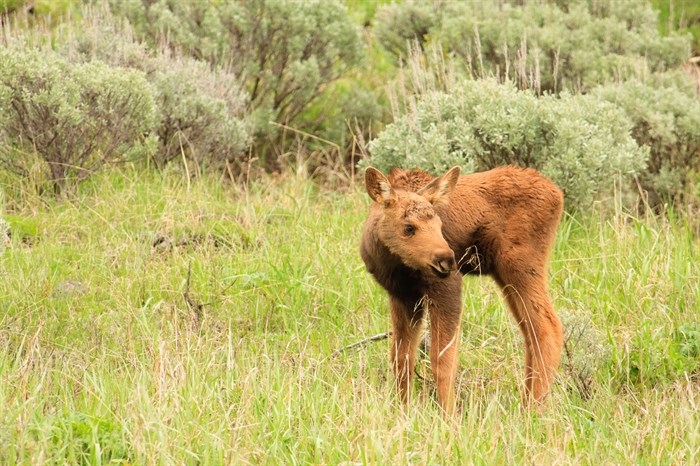
Image Credit: ADOBE STOCK
April 11, 2021 - 6:00 PM
In the last 10 to 15 years, moose populations across B.C. have declined between 50 to 70% and researchers are finding wolves are the leading cause of death in both female adult moose and calf populations in the Interior.
Chris Procter, senior biologist with the B.C. Ministry of Forests, Lands, Natural Resource Operations and Rural Development, Fish and Wildlife, gave a presentation on Interior moose populations through a B.C. Wildlife Federation Zoom conference April 1.
During the presentation, he said declining populations overlap with habitat changes due to intense forest development associated with pine beetle timber salvage. The study areas of Interior moose populations include Bonaparte Plateau north of Kamloops, Big Creek southwest of Williams Lake, Prince George south, Entiako Provincial Park and northwest of Prince George.

Moose study areas in the Interior
Image Credit: FACEBOOK/B.C. Wildlife Federation
The ongoing study began in 2012 and so far researchers have collared a total of 540 adult cows and 180 eight-month-old calves. They also assessed moose body conditions, collected fecal samples and conducted biopsies to determine cause of death, Procter said.
Female moose were found to have an 85% survival rate when compared to other stable moose populations, Procter said. Cows captured were relatively healthy and “so far we have not identified any wide-reaching or pervasive health determinants expected to have large scale effects on moose populations,” he said.
Fifty-seven percent of cow deaths were caused by predation and 44% of these total deaths were caused by wolves. Only 20% of deaths were health-related followed by 13% caused by hunting. Winter tick populations did also not appear to be a significant issue for the moose population, he said.
READ MORE: Harbour seals prime suspect in decline of steelhead populations in Thompson watershed
Mortality rates were highest among cows in the spring season, between March to May, likely because of snow conditions and because moose are naturally in poorer condition during that time of year after using their fat reserves throughout winter, he said.
Throughout the study, moose populations continued to decline in some areas by as much as 37%, despite normal adult female survival rates.
“Likely calf recruitment is a bigger thing to focus on,” Procter said.
Currently, University of Victoria students are still working to answer how landscape changes and maternal conditions contribute to calf survival rates.
Researchers found 30% of calves studied died before age one. Predation by wolves was the leading cause of death with 79% of deaths caused by the carnivores, followed by apparent starvation at 19%.
Newborn calf survival rates, which have yet to be fully researched, are estimated to be between 22-66%, he said.
The research collected from the project is currently being compiled into evaluations of how the landscape changes correlate with moose mortality rates, on overall moose health and how wolf predation risk relates to landscape change, he said.
Procter recommended for forestry managers to limit the construction of new roads and rehabilitating roads following a timber harvest, to increase local landscape heterology by creating smaller clearings and avoiding high proportions of new cutblocks, to maintain small, mature stacks of timber, maintain screening cover around cutblocks and important habitat features and noted cutblocks do not necessarily maintain stable moose populations so managers should consider forest regrowth and vegetation composition during forestry planning.
To watch the whole B.C. Wildlife Federation video, visit the non-profit's Facebook page.
To contact a reporter for this story, email Carli Berry or call 250-864-7494 or email the editor. You can also submit photos, videos or news tips to the newsroom and be entered to win a monthly prize draw.
We welcome your comments and opinions on our stories but play nice. We won't censor or delete comments unless they contain off-topic statements or links, unnecessary vulgarity, false facts, spam or obviously fake profiles. If you have any concerns about what you see in comments, email the editor in the link above.
News from © iNFOnews, 2021